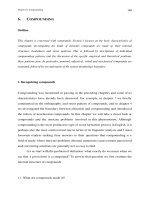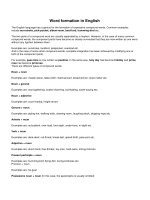Word order in english by viv quarry
Bạn đang xem bản rút gọn của tài liệu. Xem và tải ngay bản đầy đủ của tài liệu tại đây (106.63 KB, 3 trang )
25/2/2016
Word Order in English by Viv Quarry
Word Order in English by Viv Quarry
by Viv Quarry (www.vivquarry.com)
1. Position of adverbs.
Adverbs of frequency:
And some other adverbs like: also, only, probably, almost, even, all & both
COME BEFORE THE MAIN VERB.
Eg. Jack hardly ever watches television and rarely reads newspapers.
She almost fell over as she came down the stairs.
However, they must come BEFORE 'have to'.
Eg. We always have to wait a long time for a bus.
These adverbs come AFTER the verb 'TO BE'.
Eg. The traffic isn't usually as bad as it was this morning.
Why are you always late? You're never on time.
BUT AFTER AUXILIARY verbs (WILL, DO & HAVE) and the modals CAN, MUST, SHOULD & MIGHT.
Eg. It will probably rain tomorrow.
She doesn't usually smoke.
My parents have always lived in London.
John's car has probably been stolen.
I can never remember his name.
/>
1/3
25/2/2016
Word Order in English by Viv Quarry
You must always do your best.
He should be more punctual and he should also work harder.
If he had arrived sooner he might never have missed the bus.
In negative sentences, probably comes before the negative.
Eg. I probably won't see you. or I will probably not see you. He still hasn't done it yet.
Adverbs do not usually come between a verb and a direct object.
Eg. I like tennis very much He drove the car very fast.
2. Word order in sentences.
The most common word order in sentences is : SUBJECT + VERB + OBJECT.
English sentence structure usually follows the pattern:
1. WHAT Eg. He was lying quietly |1 You worked hard |1 He stayed
2. WHERE in bed. |2 |2 in the office
3. WHEN |3 today. |3 until 3pm.
However, in very long sentences with various clauses it is better to start with the WHEN clause.
Eg. Last year I spent three months working on a project at Shell Centre in London.
Verbs can be followed by a direct object (THING) and an indirect object (PERSON).
THE PERSON USUALLY COMES FIRST.
Eg. He owes my brother ten pounds. They read him his rights.
I bought her a car. It took him a long time.
She lent me her pen. She wrote me three letters.
The policeman showed me his ID card. Pass me the salt, please.
My father brought me home. They sent him the report.
They gave John a very nice present. She told me the answer.
They refused to give David a visa. They offered him the job.
Note! THE PERSON CAN COME AFTER THE THING (with the preposition TO or FOR) IF
/>
2/3
25/2/2016
Word Order in English by Viv Quarry
THE PERSON OBJECT (indirect object) IS MUCH LONGER THAN THE THING
(direct object).
Eg. I owe ten pounds to the brother of a friend of mine.
She gave it to the woman in the blue dress.
They brought some food for the people who had been rescued.
WHEN BOTH OBJECTS ARE PRONOUNS, THE THING MUST COME BEFORE THE PERSON.
Eg. Give it to me!
Show it to her.
Buy it for me.
THE THING (direct object) MUST ALSO COME FIRST WITH THESE VERBS :
EXPLAIN DESCRIBE REPORT INTRODUCE SUGGEST
Eg. I explained the problem to my wife.
He described the criminal to the police.
She explained the situation to the manager.
I introduced the new teacher to the students.
We suggested the idea to our boss.
/>
3/3









